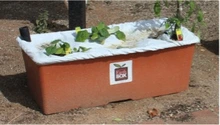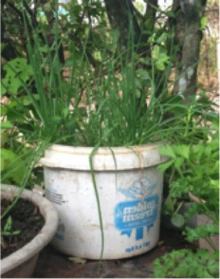Este material también está disponible en español.
You do not need access to land to grow a garden. If certain conditions are met, you can grow plants in containers in very small spaces. This publication covers the basics of container gardening in the hot, dry desert. Selecting an appropriate container, planting medium, and plant types for production are discussed.
Advantages
- Any space with access to sufficient light can host a container garden, no matter how small.
- Weeds and other pests are more easily managed in containers.
- Using containers makes gardening accessible to all people, including those with limited mobility and flexibility.
- Different plants in separate containers can be grouped together for novel color and texture combinations.
- Plants with different irrigation requirements can be managed separately but within the same small space.
Challenges
Smaller containers dry out faster and are more prone to temperature fluctuations. Container gardens require more frequent watering and fertilizing than gardens grown in the ground.
Plant selection
As long as a plant’s water, light, space, and nutritional needs are met, planting medium and location, any plant can be grown in a container. To grow root vegetables like carrots, the container must be deep enough to accommodate the roots. Tall plants will also require a deep and wide container so that the roots can adequately anchor the plant. Additionally, a stake or trellis may be needed to provide support for tall plants, such as tomatoes.
Characteristics of a good Container
You may be surprised at the things that can be used as a container. Your selection should be based first on what supports good plant growth and development. What is pleasing to the eye is second! Even something unattractive but utilitarian can be decorated to look good. An appropriate container for gardening should meet the four requirements below.
Large enough to support a mature root system. Larger containers give plants more rooting space, are less vulnerable to temperature fluctuations and will not require as frequent irrigation as smaller containers. The larger the container and the more soil and water it holds, the heavier it will be and more difficult to move. Put larger containers on wheels or casters to permit moving plants around. This is great for frost sensitive small trees like limes that will need to be moved into a shelter when it becomes too cold.
Provides adequate drainage. Plant roots require oxygen. If the container does not allow excess water to drain away from root, they will suffocate and die. Also, certain plant fungal diseases thrive in standing water. A good container allows excess water to drain freely out of the pot, but keeps the soil in. Drainage holes can become clogged by soil or roots over time, so be sure to periodically check for adequate drainage. Several, small drainage holes are preferred to one large one.
Retains the planting medium. The planting medium should not get washed out of the container during irrigation.
Not made of toxic materials and was not used to store toxic materials. Be sure that there are no residual substances that may be leached from the container into the soil that are harmful to the plant or, if the container is used to grow food plants, substances that are toxic to humans.
Be creative when selecting a container. Consider giving a second life to objects that might otherwise be discarded and end up in a landfill.
- Planting directly into the potting soil bag. Lay the bag on its side, cut a hole in the top for the plant and poke some drainage holes in the bottom for an instant garden.
- Leggings, tights, and nylon stockings can be filled with planting medium and hung up to take advantage of available vertical gardening space.
- Old toilets, tubs and sinks already have drainage holes and will last a lifetime. Restaurants and other food service establishments sometimes give away large, plastic buckets.
The material that the roots grow in is called the planting medium. You can purchase a pre-mixed planting medium from a garden center or nursery, or make your own. Some mixtures contain soil, others are soilless. The planting medium you select is determined by the type of plants you are growing. Here are some characteristics of a good planting medium for container gardens.
Planting medium
Free of weed seeds, diseases and other pests. Since plants are growing in a very limited root environment, it is important to eliminate weed competition. Garden soil taken directly from the ground is likely to contain many weed seeds that will germinate and steal water and nutrients from your plants. Garden soil can be pasteurized before using in containers (see side bar).
Drains well. Roots require oxygen and unless they are aquatic plants they have difficulty extracting oxygen from water. Native desert soil often has a high clay content, which tends to drain very slowly and should be avoided in containers. Do not place gravel or stones in the bottom of the container, as this will limit the space available for colonization by roots.
Has good water holding capacity. Finding the balance between proper drainage and water holding capacity in your container garden is a challenge. Because of their limited size, containers tend to dry out very quickly. Sand improves drainage; organic matter such as peat moss and compost increase water holding capacity.
Lightweight and loose enough for root penetration. Planting media that contain soil with a high clay content can become very hard, limiting root growth.
Below are planting media recipes you can make at home. Mix all ingredients in equal parts.
- Recipe 1: Peat moss, clean garden soil*, coarse builder’s sand
- Recipe 2: Finished compost, coarse builder’s sand, peat moss
- Recipe 3: Finished compost, coarse builder’s sand, Clean garden soil
*Garden soil can be pasteurized by heating in the oven. Place moist soil in an oven heated to 250°F. Use a meat thermometer to monitor the internal temperature of the soil. Once it has reached 180°F continuously for 30 minutes, most weed seeds, insects and disease organisms will be killed. Be advised that this process may produce an unfavorable odor in your home.
Water, fertilizer and light
Salt Accumulation and Leaching
Tap water quality varies significantly from location to location. In our desert environment, most tap water has a fairly high salt content. Every time we water plants with tap water, we add salt to the planting medium. Fertilizers are also salts, and as we fertilize our container plants, the salt content of the medium increases. Excess salt is toxic to plants, just as it is to humans. The most obvious symptom of “salt burn” is a browning and death of the tip and/or edges of the leaves that is bordered by a yellow “halo”. To remove (leach) accumulated salts from the containers, periodic applications of large amounts of water are necessary. Be sure that the excess water during these leaching events drains quickly and easily away. Softened water should not be used to water plants because of the high salt content.
Fertilizer
Plants grown in the ground have access to a much larger volume of soil and the nutrients the soil contains. Nutrients in container planting medium are continually drawn from the medium by plants and need to replenished. Many successful container gardeners apply a weak solution of a complete fertilizer with micronutrients frequently. Most commercial potting mixes contain fertilizer.
Light Requirements
Different plants have different light requirements. Indoor light quality and quantity tends to be inadequate for plant growth. Most common houseplants are tropical, understory species that are adapted to very low light conditions and do well indoors. If placed outdoors in direct sunlight, they quickly sunburn, dry out, and die. Fruiting plants, such as tomatoes, melons, and citrus have much higher light requirements and require several hours of bright light each day to survive, grow, bloom and produce fruit. A sunny, south-facing windowsill will likely provide enough light to grow many vegetable crops. Leafy greens can grow well under partly sunny conditions. Understanding the needs of each plant and placing it in the right location where it gets the proper amount of light is crucial to the success of your container garden. Bear in mind that if the container is outdoors in full sun, the planting medium and roots can get very hot. Try to keep the container in the shade, while allowing leaves access to light.
Growing vegetables
Vegetable* | Light | Minimum | Inches between plants | Days from seed | Comments |
|---|---|---|---|---|---|
| Beans, Bush | FS | 2 gal. | 2 - 3 | 45 - 60 | Several plantings, 2-week intervals |
| Beets | FS/PS | 1/2 gal. | 2 - 3 | 50 - 60 | Thin plants when 6 - 8” tall |
| Carrots | FS/PS | 1 qt. | 2 - 3 | 65 - 80 | Several plantings, 2-week intervals |
| Cabbage | FS/PS | 5 gal. | 12 - 18 | 65 - 120 | Requires fertile soil |
| Chard, Swiss | FS/PS | 1/2 gal. | 4 - 6 | 30 - 40 | Harvest leaves |
| Cucumbers | FS | 5 gal. | 14 - 18 | 70 - 80 | Requires hot weather, Support vining types |
| Eggplant | FS | 5 gal. | 1 / container | 75 - 100 | Requires fertile soil |
| Kale | FS/PS | 5 gal. | 10 - 15 | 55 - 65 | Harvest leaves |
| Lettuce, Leaf | PS | 1/2 gal. | 4 - 5 | 35 - 40 | Several plantings, 2-week intervals |
| Mustard Greens | PS | 1/2 gal. | 4 - 5 | 35 - 40 | Several plantings, 2-week intervals |
| Onions, Green | FS/PS | 1/2 gal. | 2 - 3 | 70 - 100 | Needs lots of moisture |
| Peppers, Bell | FS | 2 gal. | 1 / container | 110 - 120 | Requires hot weather |
| Squash, Summer | FS | 5 gal. | 1 / container | 50 - 60 | Plant only bush type |
| Tomatoes | FS | 5 gal. | 1 / container | 55 - 100 | Stake & prune or cage |
| Tomatoes, Cherry | FS | 1 gal. | 1 / container | 55 - 100 | Helps to stake & prune |
| Turnips | FS/PS | 3 gal. | 2 - 3 | 30 - 60 | Harvest leaves & roots |




